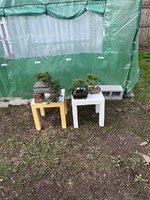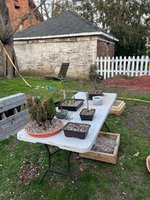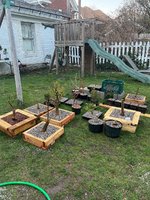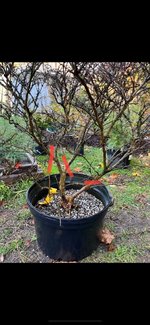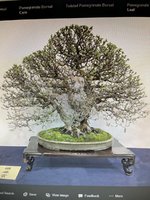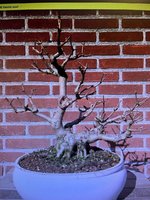With all the great advice I've received from folks on BonsaiNut, I thought maybe other newbies could benefit on some reflections on my first year of bonsai. Probably my single biggest piece of advice is find a copy of Andrea Merrigolli's maple bonsai book and study it like you would for a college exam. As far as I can tell, there is no single reference source for maple bonsai anywhere near as thorough as Andrea's. IMHO, bonsai is a particularly holistic art that requires a good deal of knowledge in an array of topics to succeed. There is a certain amount of foresight required to develop a tree and I would argue that a newbie is destined to acquire these skills the hard way (read "dead trees") without having at least a general overview of the entire process. This book is an indispensable tool for anyone looking to grow maples (or other deciduous trees). This is not a casual read, coffee table book - it is encyclopedic and dense, requiring study.
"It depends" - probably one the biggest and most frustrating refrains in all of bonsai. But, of course, it depends. Different trees will require different care, so a general question on bonsai care will always be met with "it depends". Different cultivars within the same species will require different treatment, so it depends. A maple growing in Germany doesn't have the conditions as one growing in North Carolina, so it depends. A formal upright and literati aren't developed the same way, so it depends. The upshot of this is two-fold - first, be as exact as you can be when asking questions to elicit a more exact response. Folks here are pretty free with sharing their experience, so if someone with experience tells you it depends, it's because there are many nuances that need to be explored. Second, context is very important. In bonsai, we cannot always extrapolate from one situation to another, so it is crucial to understand the exact context in which advice is being given so that it is not applied incorrectly.
Practice and experiment - As disappointing as it may be, the first tree we develop will likely not be an award winner. Practice every aspect of what you learn. Wire the branches of trees in your backyard to get a feel for it. Bend trunks until they snap. Find a scar and try to fix it. Work on roots. Air layer. There is no substitute for hands on experience. Find cheaper material to work on. Your more expensive material will thank you for it. One of the biggest advantages the more experienced practitioners have is an understanding of how the tree will react to their work. So experiment and see what happens.
Soil components - This is a particularly confusing topic, especially for beginners, and one that no one seems to really agree upon. This is one area where "it depends" is the best answer. This is because soil doesn't exist in a vacuum. Rather, soil, climate and the bonsai practitioner are 3 aspects of soil that go hand in hand. Provided you stay far away from potting soil, there are any number of acceptable soil choices. Those choices will be somewhat winnowed down by the particular tree in question. Local climate will impact one's choice of soil components more profoundly. Some climates may require more water retention than others. Freeze/thaw cycles may impact one's decision whether to use akadama. Once your tree's needs are understood and local climate factored in, the habits/time constraints of the bonsai practitioner need to also be considered. Someone with lots of time on their hands may be able to watch the soil during the summer months and water as often as needed. Maybe organics aren't needed as much for this practitioner. The person with a day job cannot dedicate this type of attention and will need a more "hand's off" soil that requires less attention.
"It depends" - probably one the biggest and most frustrating refrains in all of bonsai. But, of course, it depends. Different trees will require different care, so a general question on bonsai care will always be met with "it depends". Different cultivars within the same species will require different treatment, so it depends. A maple growing in Germany doesn't have the conditions as one growing in North Carolina, so it depends. A formal upright and literati aren't developed the same way, so it depends. The upshot of this is two-fold - first, be as exact as you can be when asking questions to elicit a more exact response. Folks here are pretty free with sharing their experience, so if someone with experience tells you it depends, it's because there are many nuances that need to be explored. Second, context is very important. In bonsai, we cannot always extrapolate from one situation to another, so it is crucial to understand the exact context in which advice is being given so that it is not applied incorrectly.
Practice and experiment - As disappointing as it may be, the first tree we develop will likely not be an award winner. Practice every aspect of what you learn. Wire the branches of trees in your backyard to get a feel for it. Bend trunks until they snap. Find a scar and try to fix it. Work on roots. Air layer. There is no substitute for hands on experience. Find cheaper material to work on. Your more expensive material will thank you for it. One of the biggest advantages the more experienced practitioners have is an understanding of how the tree will react to their work. So experiment and see what happens.
Soil components - This is a particularly confusing topic, especially for beginners, and one that no one seems to really agree upon. This is one area where "it depends" is the best answer. This is because soil doesn't exist in a vacuum. Rather, soil, climate and the bonsai practitioner are 3 aspects of soil that go hand in hand. Provided you stay far away from potting soil, there are any number of acceptable soil choices. Those choices will be somewhat winnowed down by the particular tree in question. Local climate will impact one's choice of soil components more profoundly. Some climates may require more water retention than others. Freeze/thaw cycles may impact one's decision whether to use akadama. Once your tree's needs are understood and local climate factored in, the habits/time constraints of the bonsai practitioner need to also be considered. Someone with lots of time on their hands may be able to watch the soil during the summer months and water as often as needed. Maybe organics aren't needed as much for this practitioner. The person with a day job cannot dedicate this type of attention and will need a more "hand's off" soil that requires less attention.

